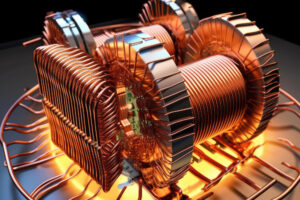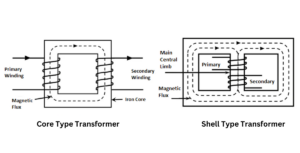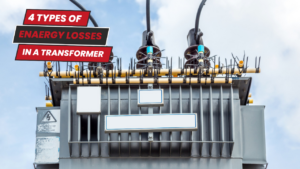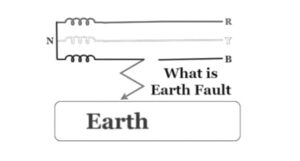Have you ever wondered about the magic behind those massive power transformers that silently work their wonders, ensuring a steady supply of electricity to our homes, schools and workplaces? It is fascinating to think about how a seemingly simple device can play such a crucial role in our modern lives.
Transformers are devices designed to transfer electrical energy between circuits through electromagnetic induction. Transformer core function hinges on a crucial element: the choice of winding conductor, where the primary winding, often fashioned from copper coils or copper wire, holds the key to their seamless operation. Copper’s steadfastness, boasting an impressive melting point of approximately 1,984°F (1,085°C), emerges as a pivotal factor.

Even in the challenging conditions inside a transformer where temperatures can become extremely high, copper remains strong and resilient. This unique quality helps copper maintain its shape and structure, even when subjected to intense heat during operation. If you are curious about the factors that contribute to copper’s popularity as a choice for transformer windings, continue reading to discover essential insights that illuminate this material preference.
Key Reasons to Use Copper in Transformer Windings?
1. Superior Electrical Conductivity
Copper serves as the epitome of a conductor with high electrical conductivity, enabling the smooth flow of electric current with minimal resistance. This attribute holds immense significance in transformers, where efficient energy transfer and minimal power loss are paramount. Copper windings, made of copper, maintain excellent electrical conductivity throughout the transformer’s operation, ensuring optimal performance. Additionally, copper is resistant to oxide formation and oxidation, further enhancing its conductivity and reliability in transformer applications.
2. Minimal Energy Loss
Owing to its remarkable conductivity, copper windings facilitate the seamless transmission of electrical energy from the primary to the secondary winding. This efficiency translates into minimal energy losses during the transfer process, culminating in a transformer that operates at an elevated level of effectiveness. Reduced energy loss translates into lower operational costs and contributes to a more sustainable power distribution system.
3. Effective Heat Dissipation
The copper transformer’s exceptional thermal conductivity allows for efficient transfer and dissipation of the heat generated during operation. By efficiently dissipating heat, transformers with copper windings effectively maintain safe operating temperatures, minimising the risk of performance degradation and potential damage. This reliable heat dissipation characteristic of copper contributes to the overall efficiency and reliability of copper wound transformers, making them an ideal choice for various electrical applications.
4. Longevity and Reliability
The combination of copper’s exceptional electrical and thermal properties, along with its inherent strength, contributes to the extended lifespan and unwavering reliability of transformers. Copper windings, known for their durability and resilience, can withstand the continuous demands of operation, maintaining their performance characteristics throughout the lifecycle of the transformer. When compared to aluminium, another commonly used winding material, copper’s superior strength further reinforces its suitability for long-lasting and dependable transformer performance.
5. Compatibility with Joining Techniques
Transformers are intricate assemblies comprising various components, and the integrity of their connections is of paramount importance. Copper’s compatibility with an array of joining techniques, including soldering and brazing, further elevates its allure for transformer windings and copper connections. These techniques ensure robust connections between different winding elements, contributing to the overall structural integrity of the transformer. Copper’s high thermal and electrical conductivity, excellent wetting properties, and ability to form eutectic alloys with brazing filler metals make it an ideal choice for creating strong and durable copper connections in transformers. By utilising these reliable joining techniques, transformer manufacturers can ensure optimal performance and longevity of transformers.
What are the difference between Copper and Aluminium Windings in the Transformers?
In transformer construction, the decision between copper and aluminium for windings significantly affects performance, efficiency, and durability. Both metals are used in transformers, but understanding why copper is preferred requires a concise comparative analysis. The following table outlines key attributes, shedding light on the differences between copper and aluminium in transformer coils.
| Aspect | Copper Windings | Aluminium Windings |
|---|---|---|
| Electrical Conductivity | High conductivity, low resistance, higher efficiency | Lower conductivity, higher resistance, lower efficiency |
| Thermal Conductivity | Excellent heat dissipation, temperature regulation | Effective heat absorption, distribution |
| Mechanical Strength | Robust, withstands stress, maintains shape | Less robust, vulnerable to mechanical stresses |
| Corrosion Resistance | Resistant to corrosion, enhances longevity | Prone to corrosion, potential impact on lifespan |
| Compatibility | Works well with insulation materials, effective winding | It may require special considerations for winding |
| Non-Magnetic Properties | Non-magnetic, reduces eddy current losses | Non-magnetic, reduces eddy current losses |
| Density | Higher density | Lower density |
| Cost | Potentially higher initial cost | Lower initial cost |
| Efficiency | Higher energy efficiency, reduced losses | Lower energy efficiency, increased losses |
| Connection Complexity | Soldering and connections straightforward | Connections may be more challenging |
| Overall Consideration | Preferred choice for efficiency and reliability | Cost-saving option with compromises |
Grant Transformer: Your Partner in Transformer Excellence
The choice of copper for transformer windings is not merely a tradition but a strategic decision rooted in its exceptional properties. At Grant Transformer, a leading transformer manufacturer in Australia, we recognise the critical role that copper windings play in the success of transformers. Our expertise in the field, coupled with a deep understanding of both copper and aluminium winding technologies, ensures that you’ll receive the guidance you need to make an informed decision.
Do not miss the chance to collaborate with us for transformer winding solutions that exemplify quality, efficiency and sustainability. Reach out to us today and embark on a transformative journey that ensures your energy infrastructure meets the demands of today and the challenges of tomorrow. Your choice today shapes the energy landscape of the future, and we’re here to make that choice for a resounding success.



